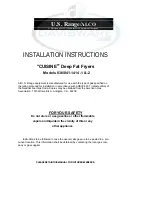
information, this data is essential for proper identification. Other information on this plate is the BTU/hr
output of the burners, outlet gas pressure in inches WC, and whether orificed for natural or propane
gas.
"CUISINE" DEEP FAT FRYERS MUST BE CONNECTED
ONLY TO THE TYPE OF GAS IDENTIFIED ON THE RATING PLATE!
Clearances
The appliance area must be kept free and clear of all combustibles. This unit is design-certified
for the following installations:
1. For locations having non-combustible walls;
2. For installation on a combustible floor when equipped with six inch legs or casters;
3. For installation without legs on a non-combustible curb or platform; and
4. For battery installation with other "Cuisine" appliances.
Mechanical
Legs or optional casters should be installed near where the appliance is to be used, as neither
are secure for long transit. After uncrating, tilt the body only high enough (or raise it about a foot) to
permit the legs or casters to be screwed into their couplings, and lower it gently to keep any undue
strain from the legs. It is strongly recommended that a pallet or lift jack be used rather than tilting.
A carpenter's spirit level should be placed across the top of the fryer and the unit levelled both
front-to-back and side-to-side. If it is not level, burner combustion may be erratic, the unit will not
function efficiently, and (in a line-up) it will not match the line visually.
If the floor is smooth and level, level the unit with the screw thread of the legs or casters; adjust
to the high corner and measure with the spirit level. If the floor is uneven or has a decided slope, level
the unit with metal shims; the adjustment required may exceed the thread available in the leg or caster
and/or a castered unit will probably not return to exactly the same position after being moved,
requiring relevelling after each move.
Form CU-DFF 08/84





































